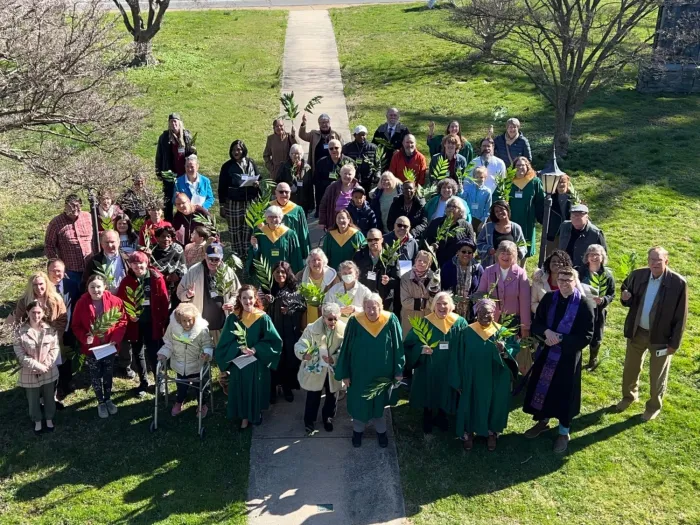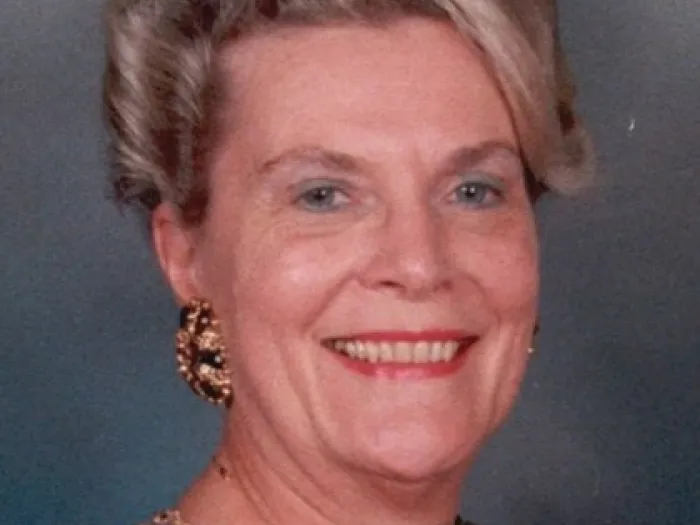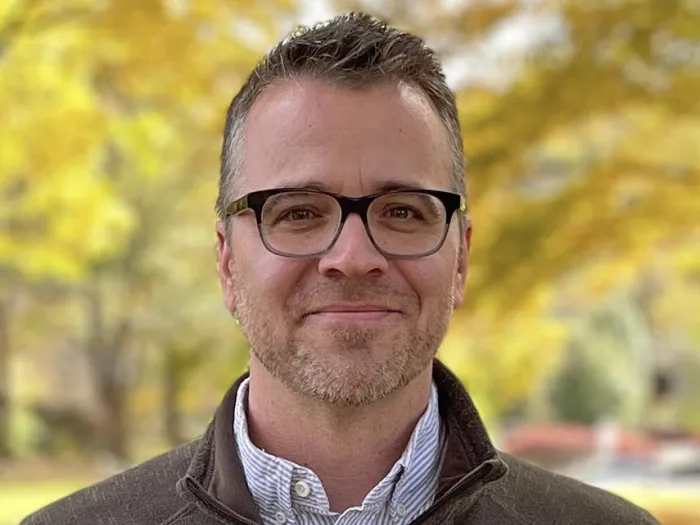Faith of the heart
Hope for ‘перемога’ inside a blue and yellow heart

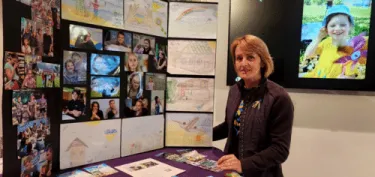
NEW YORK — In the sanctuary of avenue church nyc, Olya Balaban is unpacking small sandwich bags containing adjustable blue and yellow wrist bands — friendship bracelets in another vernacular — each adorned with a unique metal decoration. They are mementos brought from the Center for Creative Activities and Center for Sports in Izmail, Ukraine, supplementing a presentation by Balaban’s colleague, the Rev. Dr. Robert Gamble. His validated ministry, This Child Here, was initially founded to work with, and care for, many of Ukraine’s children abandoned to “the streets” in the wake of the severe economic turmoil of 2008-09; the Center, as it is more commonly known, is one outgrowth of his efforts.
All went well for most of Gamble’s first dozen years in country. Then, on Feb. 24, 2022, Russia’s president, Vladimir Putin, invaded Ukraine, widening his open hostilities begun following Ukraine’s 2014 revolution and the early stages of war; Gamble would later say during his afternoon presentation, “When war comes, you pivot.”
Seven days a week, This Child Here finds itself challenged to meet the needs of the expanded definition of “children of God.” The Center provides a safe space for families:
- Grandmothers, aunts, sisters and mothers holding down the home front — many displaced by the war — caring for their young children and, sometimes, also those orphaned by the fighting.
- Teens and young adults, many of whom once toughed it out on the streets as children now being called up to tough it out fighting for their country, if they didn’t “go over the hill,” as the saying goes, abandoning their homeland and families.
- Those of all ages with special needs because “every person matters.”
Six of those seven days are devoted to programs designed for children; on the seventh day, instead of resting, the Center devotes its primary focus to programs and discussions, offering a shoulder to lean on to the women of the area.
Life in Izmail, located in Ukraine’s western region, is relatively “quiet,” yet the battle action raging in the country’s eastern regions directly bordering Russia is omnipresent. Seven nights a week, the Center’s cellar becomes a bomb shelter-dormitory, protection against the roar of drones loudly rocketing overhead being met by the “ack-ack” of the AK-47s returning fire from the defense installations. “Comfortable” sleep is difficult.
Far away from the storm of war on this Wednesday afternoon in New York’s avenue church, one with a long history of outreach to those in need beginning from its founding in 1877 as a congregation for Czech immigrants, Balaban opens a large, thin cardboard box revealing “hope” displayed in a triptych of snapshots from life in and around Izmail and the Center, all framed by children’s drawings. Among the masterpieces in crayon, the viewer’s eye is drawn to one along the bottom left. Its colors are not quite as vivid and strong as the others, but this drawing by eight-year old Diana still provides a strong pull for the viewer: under a yellow sun in a bird-filled sky sits a small brown and tan house with a red heart on its roof. A small dog stands in the side yard facing three red flowering plants spread out along a pathway leading to a blue and yellow heart, the color scheme in the manner of Ukraine’s flag.
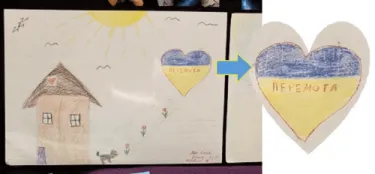
Inside the heart’s yellow portion, Diana has emblazoned the word “перемог;” Balaban translates as she points to the Cyrillic: “Peremoha – Per-eh - MO-ha,” she helpfully pronounces. “Victory. Hope for victory.”
Gamble, an eloquent storyteller, describes the catharsis of people helping people, often strangers comforting the grief of other strangers.
His remarks are accompanied by additional photos sequencing behind him on the sanctuary’s video screens. One seemingly generic picture showing a family of four brings home the war’s impact: the eyes of the young woman in the group have that “thousand-foot stare” of trauma prompted by someone trying to come to grips with the unspeakable tragedy she’s seen and experienced.
When an audience member points out this young woman’s eyes, Gamble quickly responds with four letters: “PTSD.” His answer prompts a surprised audience member to unconsciously blurt out “PTSD?”
Gamble nods “Yes,” soberly adding, “PTSD, Post-Traumatic Stress Disorder. The war is taking a toll on everyone, especially the children.” He mentions how people of all ages are trying to deal with their wartime experiences, pointing out the particular courage and tenacity of one Center volunteer, 33-year-old Alvina who, along with her seven-year-old son, survived the bombardment of Mariupol, living for days on raw slices cut from the handful of potatoes she managed to grab as they were escaping the shelling.
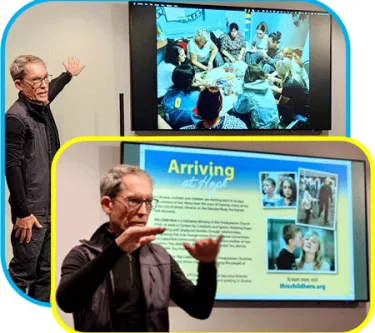
Unlike other efforts by unnamed organizations that seem to parachute into Ukraine with supplies and goods then depart, Gamble vows that This Child Here will remain in country, continuing their years of efforts to build communities. Balaban, who was born in Russia when it was spelled “CCCP,” echoes the sentiment. “I see hope with the generation that has grown up with 30 years of Ukraine freedom.”
As Gamble wraps up his presentation, one final audience member wonders: “Can the displaced families and children ever get back to their homes?” Gamble doesn’t sugarcoat his response: “That’s going to be difficult. Neighborhoods are gone. Homes and other buildings are gone. But hope is not gone.”
Then, putting on his virtual clerical collar, Gamble asks, “What did Paul write in his letter to the Romans (5:3-5; RSV translation)? ‘… suffering produces endurance, and endurance produces character, and character produces hope, and hope does not disappoint us, because God’s love has been poured into our hearts through the Holy Spirit which has been given to us.’”
Jim Nedelka, a member and ruling elder at avenue church nyc in Manhattan, has contributed to Presbyterian News Service since 2008. His career honors include an Associated Church Press award, a duPont-Columbia University Silver award, and a George F. Peabody award. His most recent article for Presbyterian News Service, “Presbyterian History made in Manhattan,” noted the celebratory chartering of Trinity Presbyterian Church in Fort Washington Heights, completing a group of faithful Ghanaian immigrants’ 14-year journey from fellowship to church.
You may freely reuse and distribute this article in its entirety for non-commercial purposes in any medium. Please include author attribution, photography credits, and a link to the original article. This work is licensed under a Creative Commons Attribution-NonCommercial-NoDeratives 4.0 International License.


